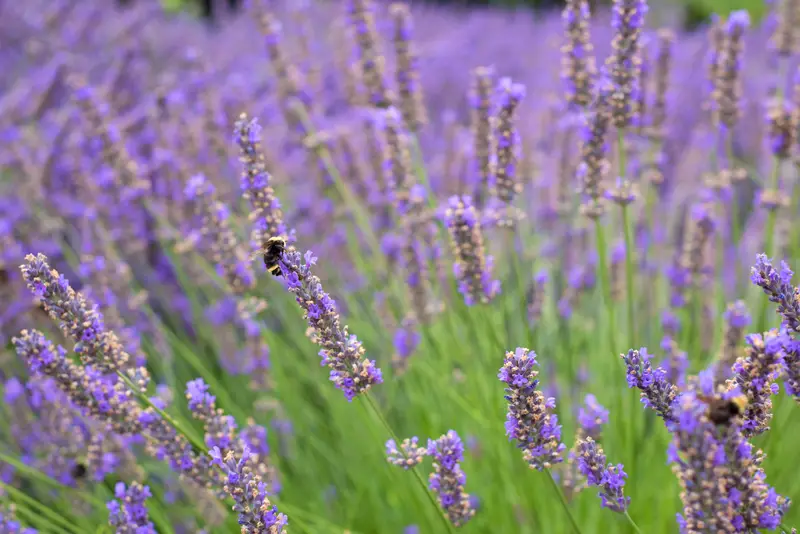Imagine spotting a grey lavender amidst all the bright colored flowers. That’ll only pull down the radiant of the entire garden. Moreover, it might even pose a threat to its fellow plants if a deadly fungus causes it.
But the main question is, what are the primary reasons for the lavender plant turning gray?
Well, if you want to know the answer behind this commonly asked question then have a look below. That’s because we’ll explain to you the full story, that too in detail.

As an Amazon Associate, I earn from qualifying purchases.
2 Major Reasons for Lavender Plant Turning Gray
As a gardener, you might get downhearted after seeing some gray lavenders. And who can blame you? It’s hard to see your precious little plants wither away in front of your eyes.
But there are ways to prevent this. However, before learning about the solution you should know the main cause of this problem. And there are 2 primary reasons behind this problematic scenario. Stay tuned to know about them.
Reason 1- Water Overflow
One of the common reasons for spotting gray lavender plants is excess water. You see, the lavender plants don’t like moist and soggy soil.
So, if you have soil with lousy drainage, then your plants will be in big trouble. At the same time, watering the plants quite often can also leave you with gray lavender plants.
Solution- Fix the Drainage System
However, when there’s a problem, there’s always a solution. As for the excessive water, all you have to do is make sure that you don’t give the lavender more water than it can handle.
We know you might love the feeling of watering your plant, but that extra water can eventually kill your plant. Hence, it’s a good idea to water after seeing that the soil has soaked up all the water.
And while you’re at it, get a sound drainage system for your garden. This will help you to remove all the excess water from the soil.
For indoors, you can use a drainage pot to ensure the proper drainage of your plants.
| OUR RECOMMENDED DRAINAGE SYSTEM |
| Drainage Trench – Channel Drain With Grate – Black Plastic |
Reason 2- Fungus Attack
Behind every red, gray, black or yellow leaves, there’s a high possibility of fungal attacks. The majority of the time, you’ll find that the fungus causes your precious lavender to turn gray. Now, there are a lot of pathogens out there who are to blame.
But the most dangerous disease of all is the botrytis ssp. And to make things worse, it’s also the most common disease out there.
Now before you get too sad about it, there’s a way to fix the problem. So, shall we take a peek into it?
5 Steps for Tackling Fungus Disease in Lavender Plants
As promised, we’ll show you how to deal with a lavender plant that went grey because of fungus. However, before we start, we’d like to warn you. At times it becomes too late to save the prayer plants after an attack by a deadly virus.
But if it didn’t spread too much, you can save the plant. So, do you want to know how to save the poor plant? Well then, let’s see how to do that.
Step 1- Check the Root of the Plant
Firstly, you should inspect the actual condition of the plant. For this, you need to uproot the plant and examine its roots. You can use a shovel for the job.
However, while taking out the plant make sure you take it out from its roots. Otherwise, you’ll end up killing the plant.
| OUR RECOMMENDED SHOVEL |
| Nupla-72-016 Round Point ShovelAMES 25332100 Tempered Steel Round Point Shovel |
Step 2- Cut the Gray Parts
For the second step, you need to snip out the parts that have turned gray. Now for this, you can use scissors, or you can go for pruning shears for a more professional approach.
Nevertheless, make sure you cut off all the grey parts, including the roots and the leaves. And once that’s taken care of you need to throw away the wastage.
That’s because they’re infected and can tarnish all the plants in your garden.
| OUR RECOMMENDED PRUNING SHEARS |
| Fiskars 91095935J Steel Pruning Shearsgonicc 8″ Professional Premium Titanium Bypass Pruning Shears |
Step 3- Apply Fungicide on the Soil
Next up, you need to make your soil a fungus proof area. And for this, you need to apply the right fungicide.
This will kill all the fungus in your garden and save your little plants from those horrible monsters.
And while you’re at it, add ⅓ sand and ⅔ compost into the soil. This enriches the soil and keeps out all kinds of fungus from your garden.
| OUR RECOMMENDED FUNGICIDE |
| Spectracide 100507462 Immunox Multi Purpose Fungicide Spray Concentrate |
Step 4- Place the Lavender Back in the Soil
Once you properly treat the soil, you can replant the lavender plant that you uprooted. For better growth, you should plant the lavender in a new place.
This ensures that the previous fungus does not creep its way back into the plant again. Now, you might be wondering why you have to do this even though you took some steps to kill the fungus.
Well, this is simply an extra precaution. And it’s an effective one. So, do follow this.
Step 5- Take Extra Care of the Lavender
After replanting the lavender, you can’t ignore the plant. You see, you need to take care of the plant, or else the fungus might return.
By taking care, we mean don’t water the plant for 2 weeks. That’s because the water creates an atmosphere for the fungus to grow.
And we don’t want that now, do we? At the same time, keep a close eye on the plants and make sure they don’t turn gray again.
To Sum Up
Well, in short, if you see your lavender plant turning gray, then check to see if you gave it too much water. And if the water’s not the case, then it’s probably the troublesome fungus.
But you also know how to tackle that. So, relax, folks. You got this. Anyway, have a nice day. Take care. Adios!
As an Amazon Associate I earn from qualifying purchases.

